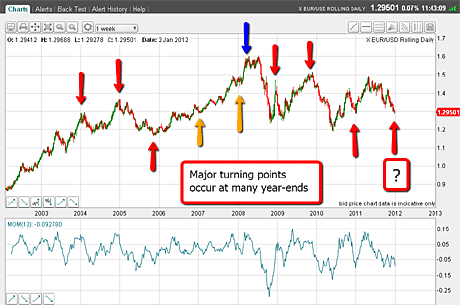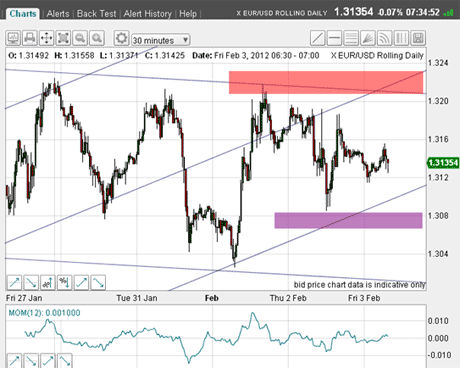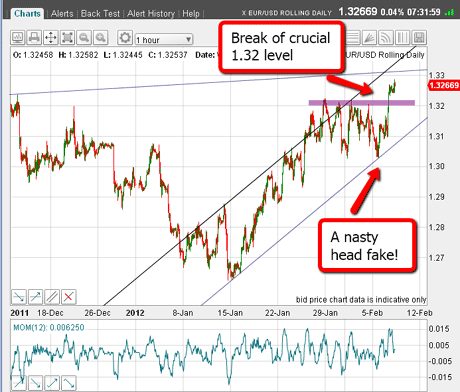The euro question has been answered
John C Burford explains how trading against the crowd can be very profitable, as illustrated by his contrarian trade in the euro.
Today, I want to stress an important rule about trading.
First, I don't know whether you saw it, but there was a dramatic move in the EUR/USD yesterday. We'll look at the charts in a moment.
But this critical development vividly illustrates why swing traders need to be flexible. We must be willing to see the evidence of the charts, and then trade either long or short as the case may be.
MoneyWeek
Subscribe to MoneyWeek today and get your first six magazine issues absolutely FREE

Sign up to Money Morning
Don't miss the latest investment and personal finances news, market analysis, plus money-saving tips with our free twice-daily newsletter
Don't miss the latest investment and personal finances news, market analysis, plus money-saving tips with our free twice-daily newsletter
I call this rule the 'never marry your beliefs' rule. The market is the sole arbiter of the eternal traders' question: Shall I buy, sell, or stand aside? And the market has no opinions.
Why traders must always be prepared to change their view
We all have a bias based on our understanding of the 'fundamentals' for either being bullish or bearish. Sometimes this feeling (sentiment) is extreme.
You have read all the 'expert' analysis and opinions, and they conform to your view in a process of reinforcement. The more you read, the more entrenched is your opinion.
Your proposed trade is a no-brainer and cannot fail!
But as I have written before, this is a very dangerous strategy. OK, you can ride a trend for a while, but will you be able to abandon your trade (your beliefs!) and take profits on signs of a reversal? With an entrenched view, this is difficult or even impossible for most traders.
The annals of trading are littered with traders who saw a good profit turn into a major loss as they stubbornly held on to their 'old' beliefs that no longer apply.
This year, we have seen a rally of over 600 pips in the EUR/USD so far. If you were riding the bear market last year, you would have seen a good profit on paper.
But if still holding your shorts today, either your profit would be severely reduced or you'd be facing a loss, depending on your entry level.
I am just not prepared to be a trade-and-hold trader and see this happen to my account. The effect might be to make me panic and cover my position just when the market was ready to roll over giving me a double whammy of taking a major loss and then seeing the market go my way!
Being mentally balanced is one of the key requirements for happy and successful trading. And that is why I advocate swing trading, not trade-and-hold.
Of course, it takes diligence and hard work to trade the swings as markets can move very rapidly, as occurred yesterday.
How the 'ultimate contrarian trade' is playing out
In my 4 January article, The ultimate contrarian trade to kick off 2012, I posed the heretical question: Will the euro stage a big rally? I included the long-term chart showing the uncanny tendency of the euro to make major turns at the year-ends.
I suggested that this is one of the most important charts for 2012.
Here it is again:

(Click on the chart for a larger version)
As outrageous as my question seemed then, I believe I have attracted a few more converts to my cause with the subsequent 600 pip rally!
Incidentally, last year when all the talk started of a collapsing euro, I suggested again, against the mainstream of opinion that an exit of the weaker members could be very bullish for the euro, as it would leave the northern stronger nations who can withstand a strong currency.
And, of course, we must not forget the other side of the currency cross the USA. They, too, have their challenges.
One other point over the past few days as the Greece question remains unsettled and deadlines are constantly being pushed forwards we are hearing more euro-bullish comments with eurozone bond yields falling.
Why it can pay to trade against the crowd
Back in early January, there was no such bullishness. There was no "fundamental" reason to suspect a rally ahead, or any reason to go long the euro. In fact, quite the reverse.
But as it turned out that would have been exactly the correct trade. It's the old adage: Buy when all are selling/bearish and sell when all are buying/bullish. It feels unnatural for many to go against their basic emotions, but that is the correct policy. I cannot stress this often enough. Trading with the herd can be dangerous!
So, I conclude that trading exclusively on the fundamentals is highly suspect. You need charts to get a clearer picture. I rest my case.
OK, on Friday, I showed that if the market could break out either up or down of the 1.301.32 congestion zone, that would indicate the next move. Here's the chart I showed:

(Click on the chart for a larger version)
But since the market rarely gives up its treasures easily, I had to be careful. There were conflicting signals.
To start with, there was a move down later on Monday to just below the previous low last Wednesday. This would be a possible signal for me to short.
But it was a head fake. The market recovered and proceeded to rally back to the upper 1.32 area and then broke through it. You can see it clearly here:

(Click on the chart for a larger version)
I can now re-position my lower tramline and draw a new upper one. Since the break up through the 1.32 level was made, the market is approaching the upper tramline.
Note also the position of the higher trendline. This is the original line I drew off the daily chart a few weeks ago.
So the market is approaching some solid resistance and I will be watching it very carefully.
My 1.36 fantasy target, although some distance away, is a lot closer now than it was in January, when I first suggested it!
Political developments that I expect to come to a head over the next few days will likely result in added volatility in all markets.
That means I need to be watchful. Keep reading MoneyWeek Trader and I'll tell you what I see.
If you're a new reader, or need a reminder about some of the methods I refer to in my trades, then do have a look at my introductory videos:
The essentials of tramline trading
An introduction to Elliott wave theory
Advanced trading with Elliott waves
Don't miss my next trading insight. To receive all my spread betting blog posts by email, as soon as I've written them, just sign up here .
Get the latest financial news, insights and expert analysis from our award-winning MoneyWeek team, to help you understand what really matters when it comes to your finances.
John is is a British-born lapsed PhD physicist, who previously worked for Nasa on the Mars exploration team. He is a former commodity trading advisor with the US Commodities Futures Trading Commission, and worked in a boutique futures house in California in the 1980s.
He was a partner in one of the first futures newsletter advisory services, based in Washington DC, specialising in pork bellies and currencies. John is primarily a chart-reading trader, having cut his trading teeth in the days before PCs.
As well as his work in the financial world, he has launched, run and sold several 'real' businesses producing 'real' products.
-
 The graphene revolution is progressing slowly but surely
The graphene revolution is progressing slowly but surelyEnthusiasts thought the discovery that graphene, a form of carbon, could be extracted from graphite would change the world. They might've been early, not wrong.
-
 How Javier Milei led an economic revolution in Argentina
How Javier Milei led an economic revolution in ArgentinaFollowing several setbacks, Argentine president Javier Milei's pro-market reforms have been widely endorsed in a national poll. Britain will need the same